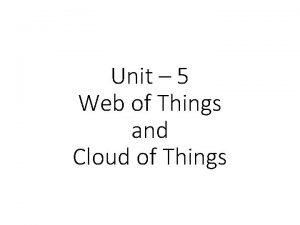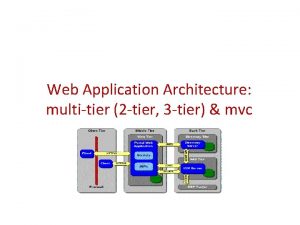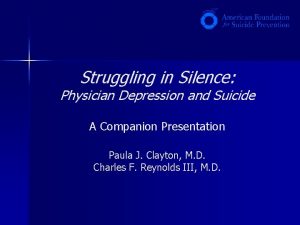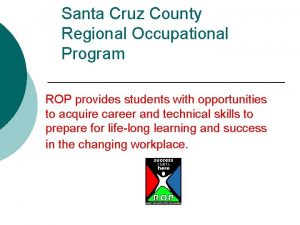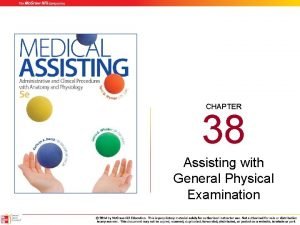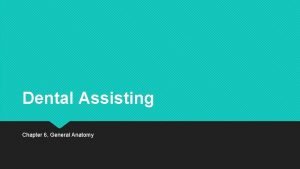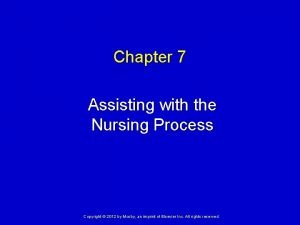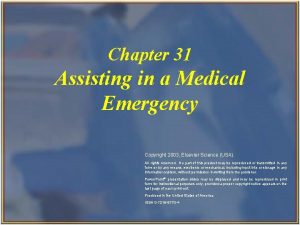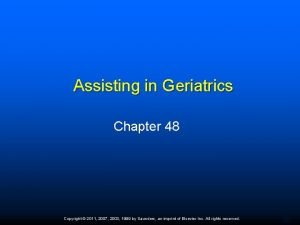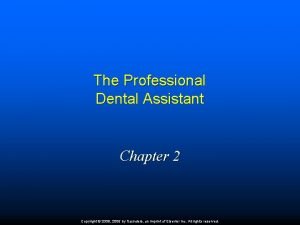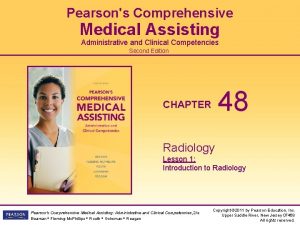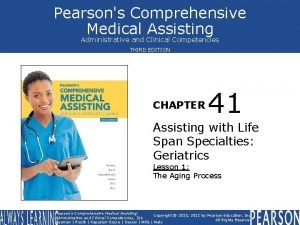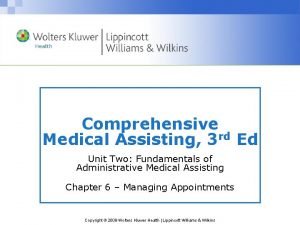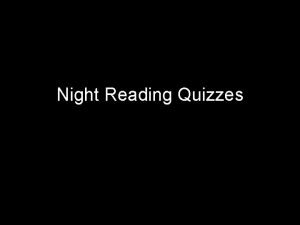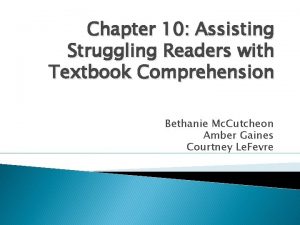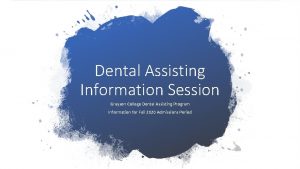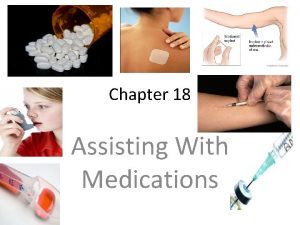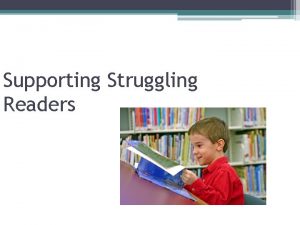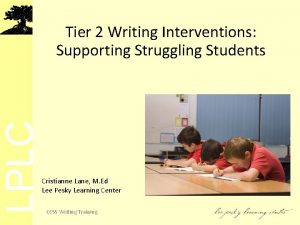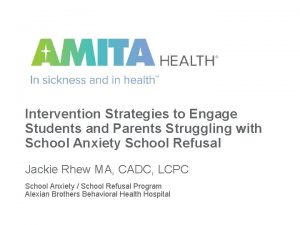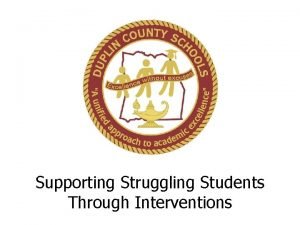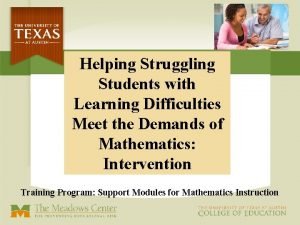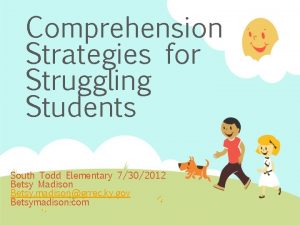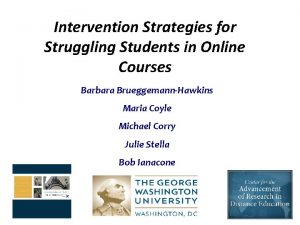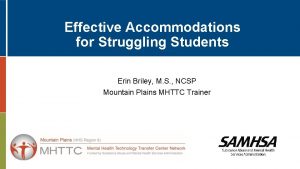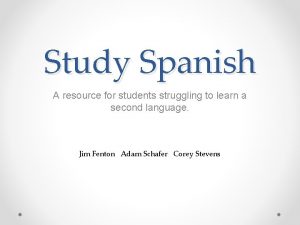Part 2 Assisting Students Struggling with Reading MultiTier




































- Slides: 36

Part 2: Assisting Students Struggling with Reading: Multi-Tier System of Supports H 325 A 120003

Note Part 2 uses content and resources from: • Center on Response to Intervention at the American Institutes for Research (http: //www. rti 4 success. org) • The Meadows Center for the Prevention of Educational Risk ©University of Texas System/Texas Education Agency

Defining MTSS Multi-Tier System of Supports (MTSS): A comprehensive system of differentiated supports that includes: • Universal screening. • Progress monitoring. • Evidence-based instruction. • Data-based decision making. 3

MTSS Is a Preventative Framework. . . • Intended to support all students • Is not a stand alone product, class, or instruction program. • Allows educators to evaluate the success of: o Grade levels/classes. o Instructional groups. o Individual students, including those with disabilities. 4

Essential Components of MTSS 1. Screening 2. Progress monitoring 3. School-wide, multi-level prevention system o o o Primary Level (i. e. , core, universal, Tier 1). Supplemental Level (i. e. , secondary, Tier 2). Intensive Level (i. e. , Tier 3). 4. Data-based decision making for: o Instruction. o Evaluating effectiveness. o Movement within the multi-level system. 5

Essential Component Screening 6

Screening • PURPOSE: Identify students who are at risk for poor reading outcomes. • FOCUS: ALL students. • TOOLS: Brief assessments that are valid, reliable, and demonstrate diagnostic accuracy for predicting learning or behavioral problems. • TIMEFRAME: Administered more than one time per year (e. g. , fall, winter, spring). 7

Areas for Screening in Early Reading • • • Letter-naming fluency. Phoneme segmentation. Nonsense word fluency. Word identification. Oral reading fluency.

Screening 9 Answers the questions: • Is core curriculum effective? • Which students need additional assessment and instruction?

Essential Component Progress Monitoring 10

Progress Monitoring • PURPOSE: Monitor students’ responses to core, supplemental, or intensive instruction to estimate rates of improvement, identify students who are not demonstrating adequate progress, and compare the effectiveness of different forms of instruction. • FOCUS: Students identified through screening as at risk for poor learning outcomes. • TOOLS: Brief assessments that are valid, reliable, and evidence based. • TIMEFRAME: Students are assessed at regular intervals (e. g. , weekly, biweekly, monthly). 11

Progress Monitoring Answers the questions: • Are students meeting short- and long-term performance goals? • Are students making progress at an acceptable rate? • Does the instruction need to be adjusted or changed? 12

Screening vs. Progress Monitoring • Close cousins. • Often, the same tools used. • It is important to distinguish: o Universal screening, which is for all students, from o Progress monitoring, which is for some students who have been identified as at risk.

Choosing Screening and Progress Monitoring Tools The Center on Response to Intervention, in collaboration with the National Center on Intensive Intervention, conduct annual reviews of tools and interventions in screening, progress monitoring, and academic intervention programs. http: //www. rti 4 success. org/resources/tools-charts

NCRTI Screening Tools Chart http: //www. rti 4 success. org/toolscharts. Landing 15

National Center on Intensive Intervention Progress Monitoring Tools Chart http: //www. intensiveintervention. org/chart/progress-monitoring 16

Multi-Level Support System 17

Essential Component Evidence-Based Interventions 18

Core Instruction • FOCUS: ALL students. • INSTRUCTION: District curriculum and instructional practices that are research based, aligned with state or district standards, and incorporate differentiated instruction. • SETTING: General education classroom. • ASSESSMENTS: Screening, continual progress monitoring, and outcome measures or summative assessments. 19

Meadows Center Clips Whole Group Instruction (9: 27) http: //resources. buildingrti. utexas. org/CAP /Differentiated_Instruction/Differentiated _Instruction. swf 20

Differentiated Instruction • FOCUS: Students of differing abilities in the same classroom. • INSTRUCTION: District curriculum and instructional practices that are research based, aligned with state or district standards, and incorporate differentiated instruction that is explicit, systematic, and includes teacher modeling. • SETTING: General education classroom. • ASSESSMENTS: Screening, continual progress monitoring, and outcome measures or summative assessments. 21

Meadows Center Clips Differentiated Core Instruction (17: 49) http: //buildingrti. utexas. org/CAP/Differenti ated_Instruction/Differentiated_Instructi on. swf 22

Supplemental Instruction • FOCUS: Students identified through screening as at risk for poor learning outcomes. • INSTRUCTION: Targeted, supplemental instruction delivered to small groups; instruction is delivered with fidelity (i. e. , consistent with the way it was designed). • SETTING: General education classroom or other general education location within the school. • ASSESSMENTS: Progress monitoring, diagnostic. Gersten et al. , 2005; Mellard & Johnson, 2007; Sanetti & Kratochwill, 2009 23

Meadows Center Clip Supplemental Intervention (25: 20) http: //buildingrti. utexas. org/CAP/Differenti ated_Instruction/Differentiated_Instruction. swf 24

Core and Supplemental Instruction • What is similar about the small group instruction provided at the core and supplemental levels of instruction? • What were the differences? • Who received instruction at the core and supplemental levels? 25

Intensive Intervention • FOCUS: Students who have not responded to core and supplemental level prevention. • INSTRUCTION: Intensive, supplemental instruction delivered individually or to small groups or. • SETTING: General education classroom or other general education location within the school. • ASSESSMENTS: Progress monitoring, diagnostic. 26

Changing the Intensity and Nature of Instruction • Match of intervention to observed skill deficit (i. e. , individualization based on assessment data). • Pedagogy. • Intervention. • Duration. • Frequency. • Interventionist. • Group size. • Behavior/motivation strategies. 27

Instruction and MTSS • College- and career-ready standards can be addressed across levels of MTSS in reading. Examples of how to apply standards-relevant instruction across core instruction, supplemental intervention and intensive intervention can be found at the link below. http: //www. intensiveintervention. org/standards-relevantinstruction-multi-tiered-systems-support-mtss-or-responseintervention#sthash. mz. Js 6 Y 9 T. dpuf

MTSS Phonological Awareness http: //www. intensiveintervention. org/standards-relevant-instructionmulti-tiered-systems-support-mtss-or-response-intervention

Essential Component Data-Based Decision Making 30

Data-Based Decision Making: The Basics • Analyze data at all levels of MTSS implementation (i. e. , state, district, school, and grade level) and all levels of prevention (i. e. , core, supplemental, and intensive). • Establish routines and procedures for making decisions. • Set explicit decision rules for assessing student progress (e. g. , state and district benchmarks, level, rate). • Use data to compare and contrast the adequacy of the core curriculum and the effectiveness of different instructional and behavioral strategies. 31

Data-Based Decision Making: Types of Decisions • Instruction. • Evaluate effectiveness within and across groups. • Movement within the multi-tiered system. 32

Mc. Kenna & Walpole, 2005 Assessment-Driven Reading Instruction 3

Need More Information? http: //ies. ed. gov/ncee/wwc/practiceguide. aspx? sid=3

Need More Information? National Center on Intensive Intervention (NCII): www. intensiveintervention. org National Center on Response to Intervention (NCRTI): www. rti 4 success. org Middle School RTI Content (NCRTI): http: //www. rti 4 success. org/rtisearch RTI Action Network: www. rtinetwork. org IDEA Partnership: www. ideapartnership. org 35

Disclaimer This content was produced under U. S. Department of Education, Office of Special Education Programs, Award No. H 325 A 120003. Bonnie Jones and David Guardino serve as the project officers. The views expressed herein do not necessarily represent the positions or polices of the U. S. Department of Education. No official endorsement by the U. S. Department of Education of any product, commodity, service, or enterprise mentioned in this website is intended or should be inferred.
 What are the three layers of data warehouse architecture
What are the three layers of data warehouse architecture Unified multitier wot architecture
Unified multitier wot architecture 3 tier web app
3 tier web app While reading activities
While reading activities Chapter 4 section 3 struggling toward saratoga
Chapter 4 section 3 struggling toward saratoga Struggling in silence
Struggling in silence Remediation of the struggling medical learner
Remediation of the struggling medical learner Chapter 4 section 3 struggling toward saratoga
Chapter 4 section 3 struggling toward saratoga The outsiders adapted for struggling readers
The outsiders adapted for struggling readers Rop santa cruz
Rop santa cruz Guest arrival and departure procedure
Guest arrival and departure procedure Chapter 42 assisting in other medical specialties
Chapter 42 assisting in other medical specialties General physical exam
General physical exam Chapter 6 general anatomy
Chapter 6 general anatomy Abstract noun of advertise
Abstract noun of advertise Chapter 5 assisting with the nursing process
Chapter 5 assisting with the nursing process Chapter 31 assisting in a medical emergency
Chapter 31 assisting in a medical emergency Assisting in microbiology and immunology
Assisting in microbiology and immunology Chapter 41 assisting in geriatrics
Chapter 41 assisting in geriatrics Juliette southard
Juliette southard Pearson's comprehensive medical assisting
Pearson's comprehensive medical assisting Pearson's comprehensive medical assisting
Pearson's comprehensive medical assisting Chapter 42 assisting in other medical specialties
Chapter 42 assisting in other medical specialties Rizal's salute to luna and hidalgo
Rizal's salute to luna and hidalgo How to develop reading skills in students
How to develop reading skills in students Developing effective reading skills
Developing effective reading skills Part whole model subtraction
Part whole model subtraction Unit ratio definition
Unit ratio definition Part part whole
Part part whole Technical descriptions
Technical descriptions Bar layout with label
Bar layout with label The phase of the moon you see depends on ______.
The phase of the moon you see depends on ______. 미니탭 gage r&r 해석
미니탭 gage r&r 해석 Pet reading part 1
Pet reading part 1 Cae reading part 6
Cae reading part 6 Scotty weems answers
Scotty weems answers Night chapter 1 quiz
Night chapter 1 quiz

